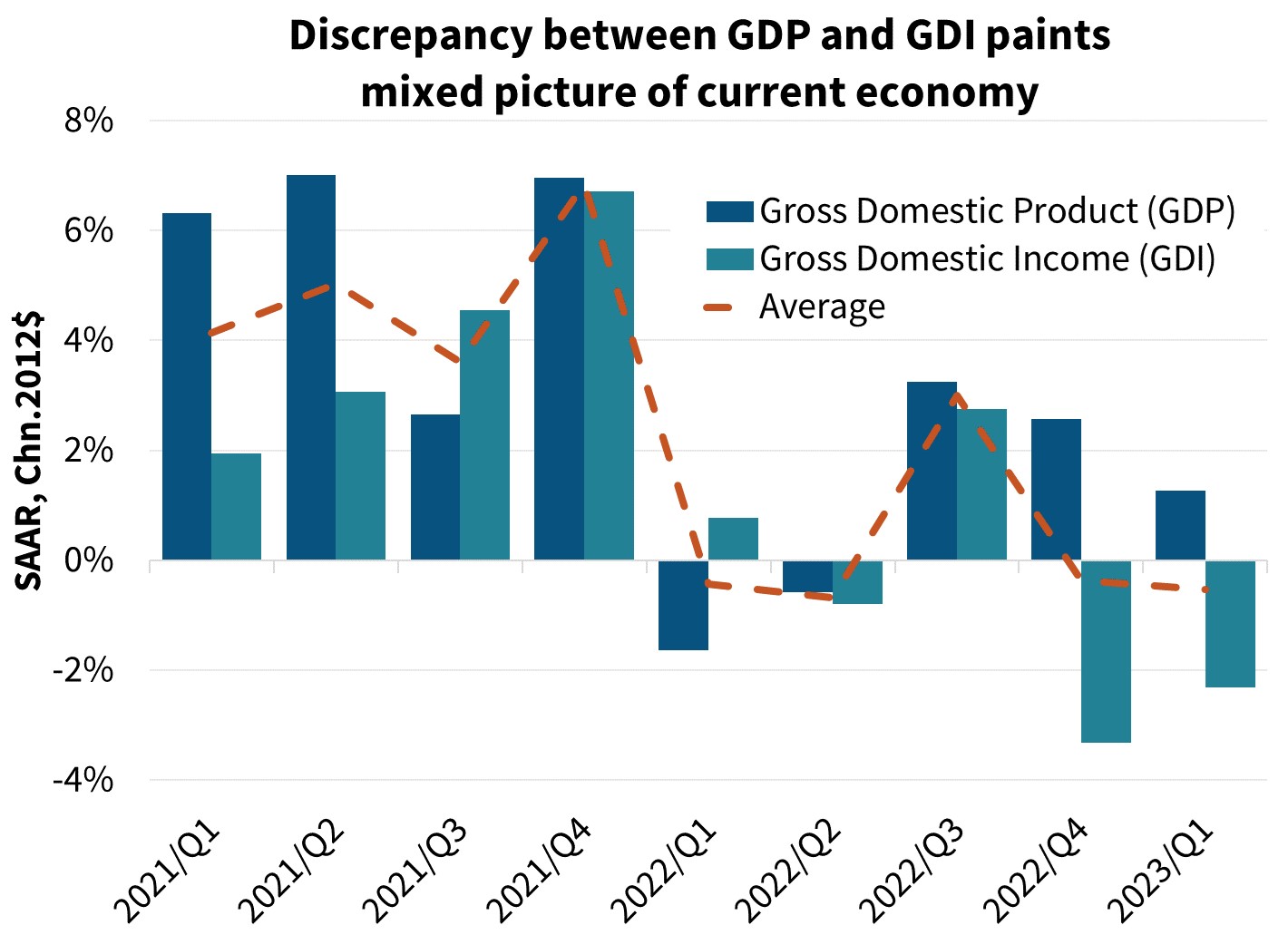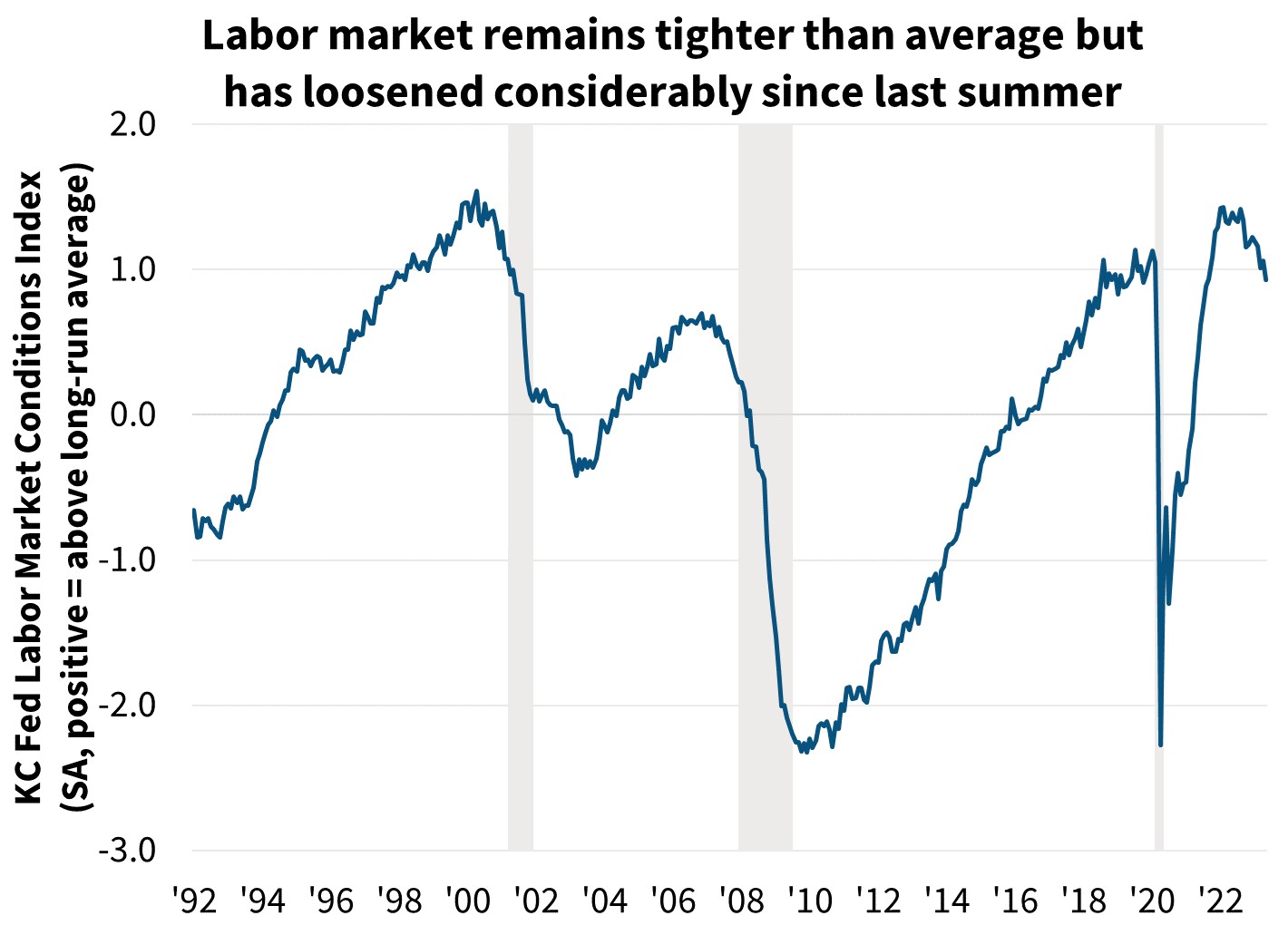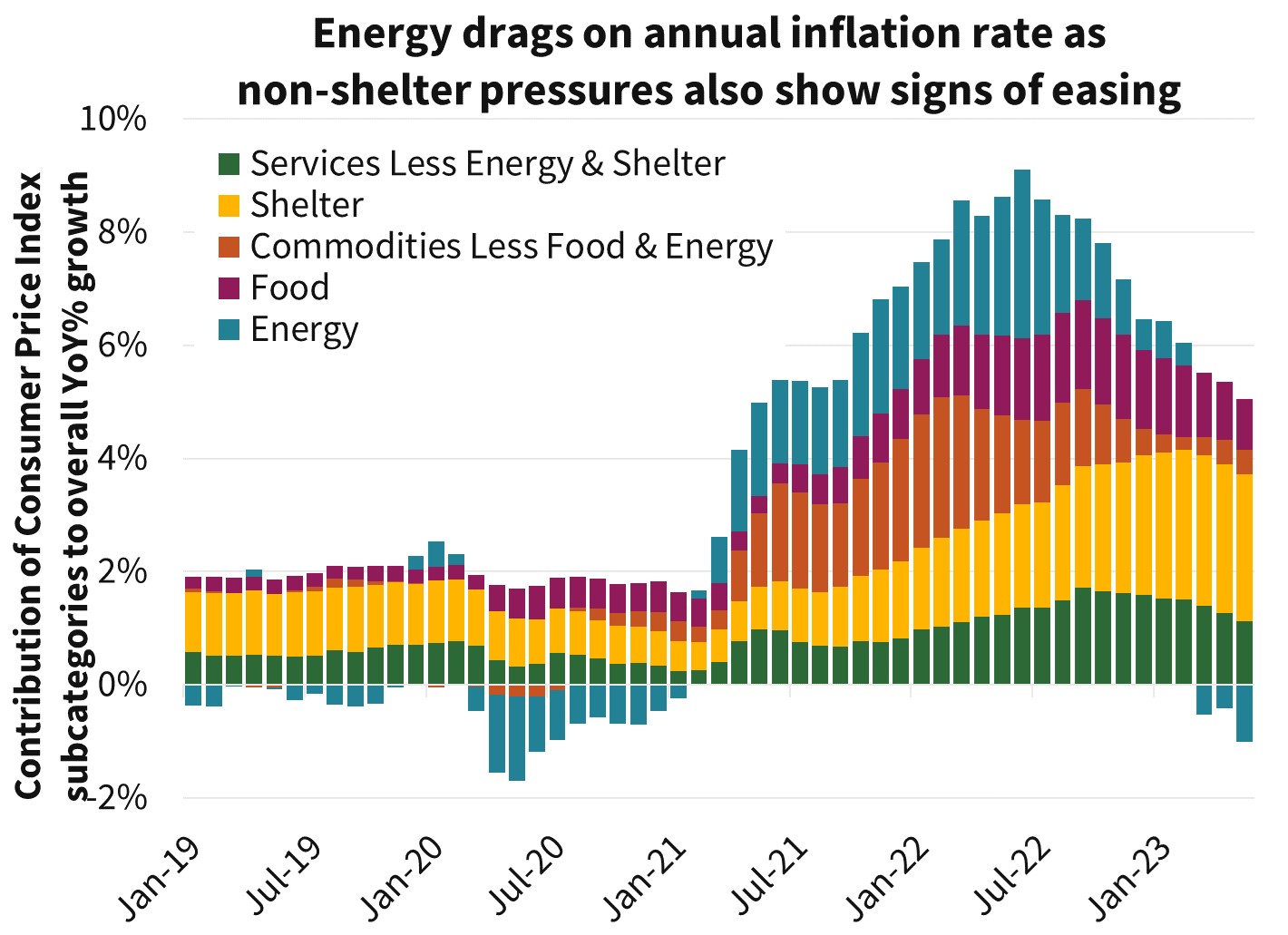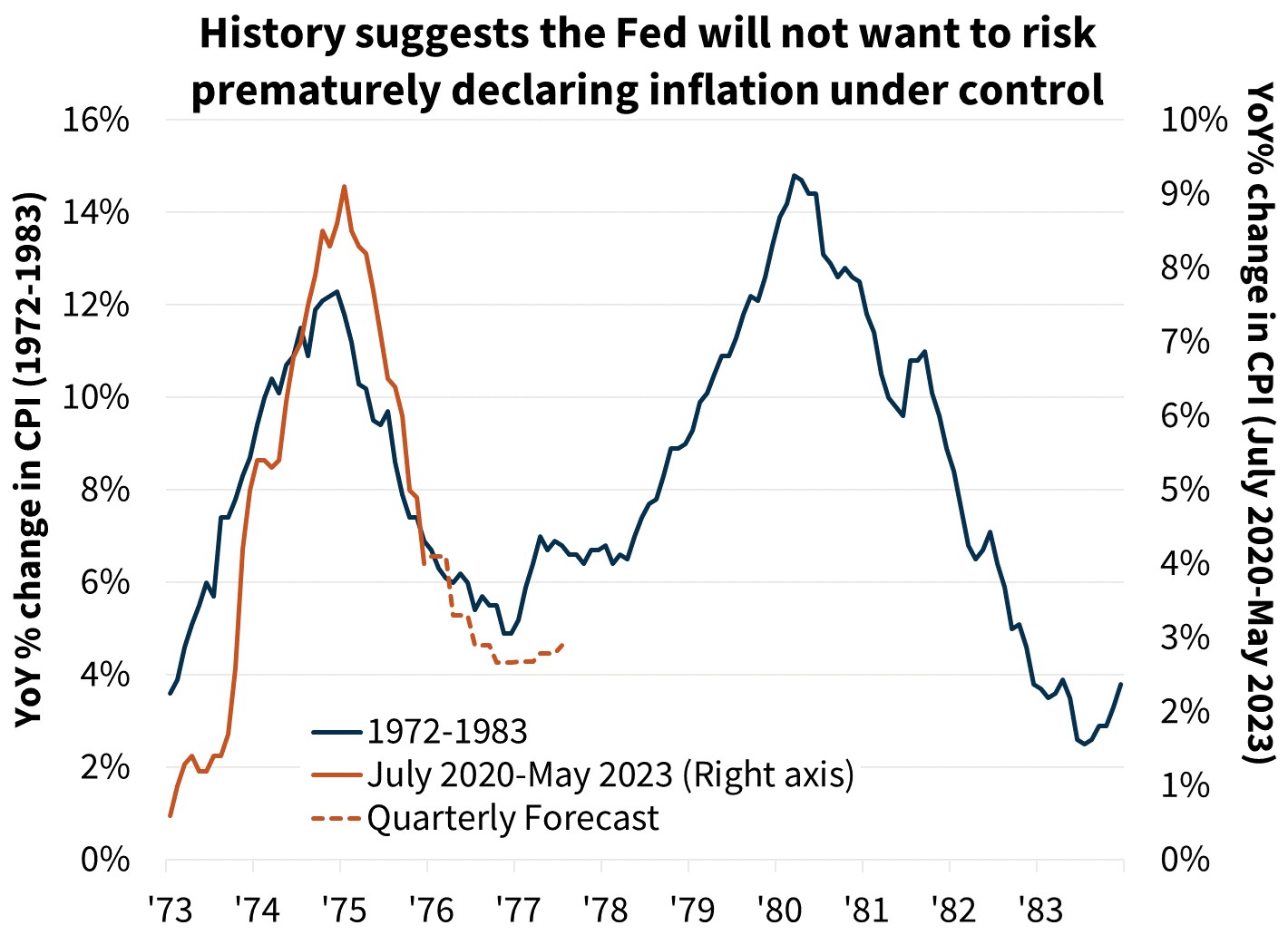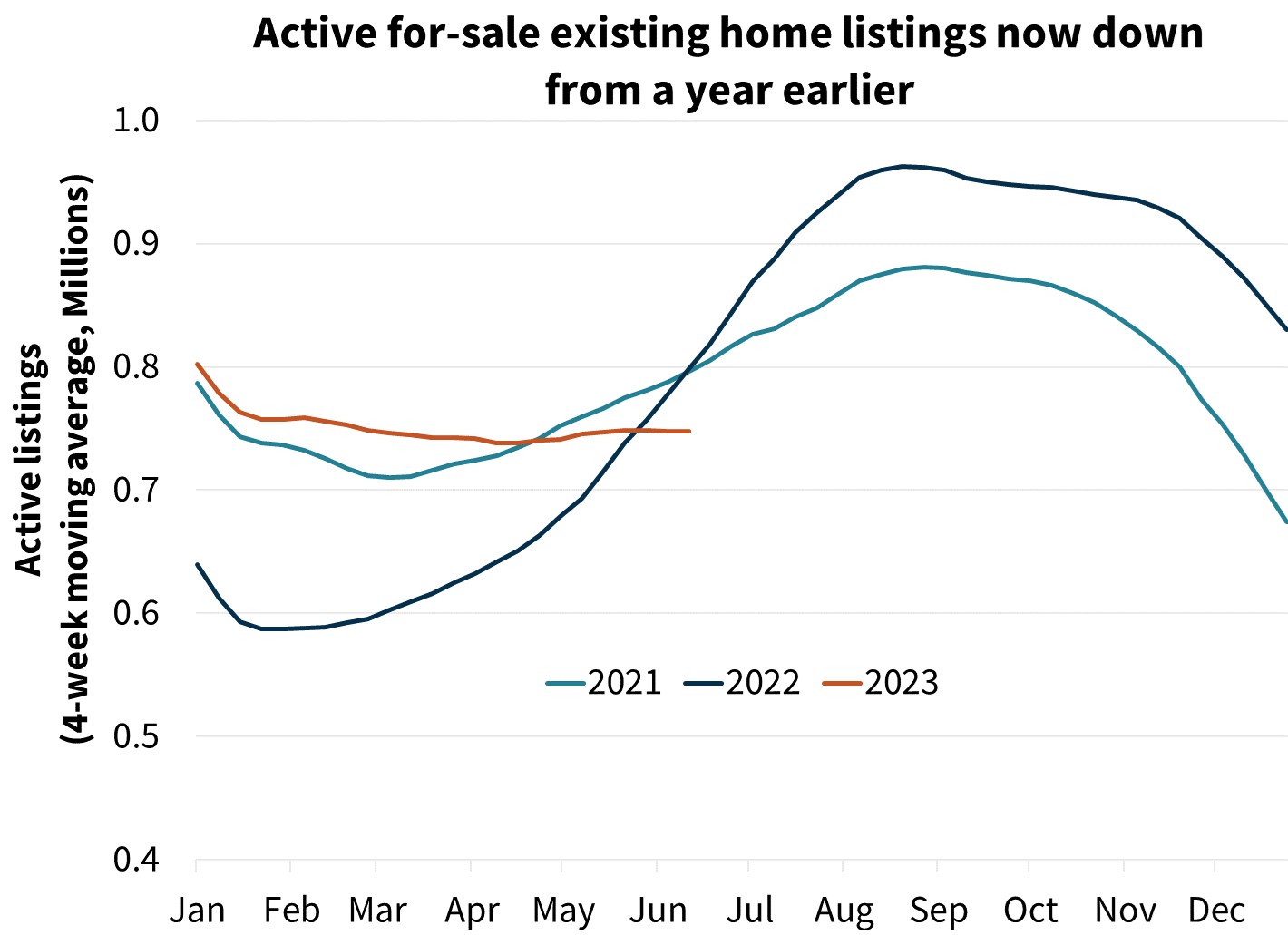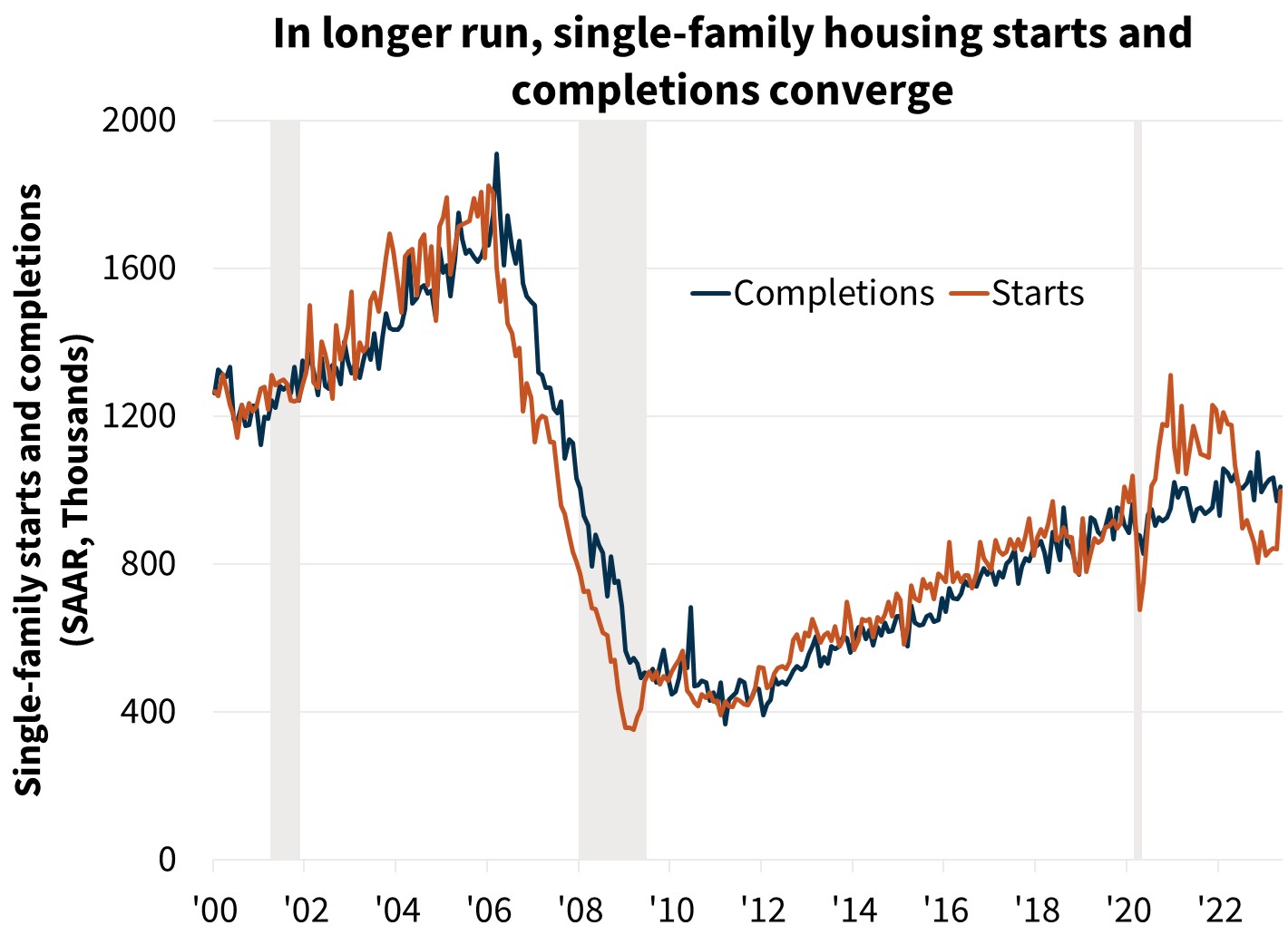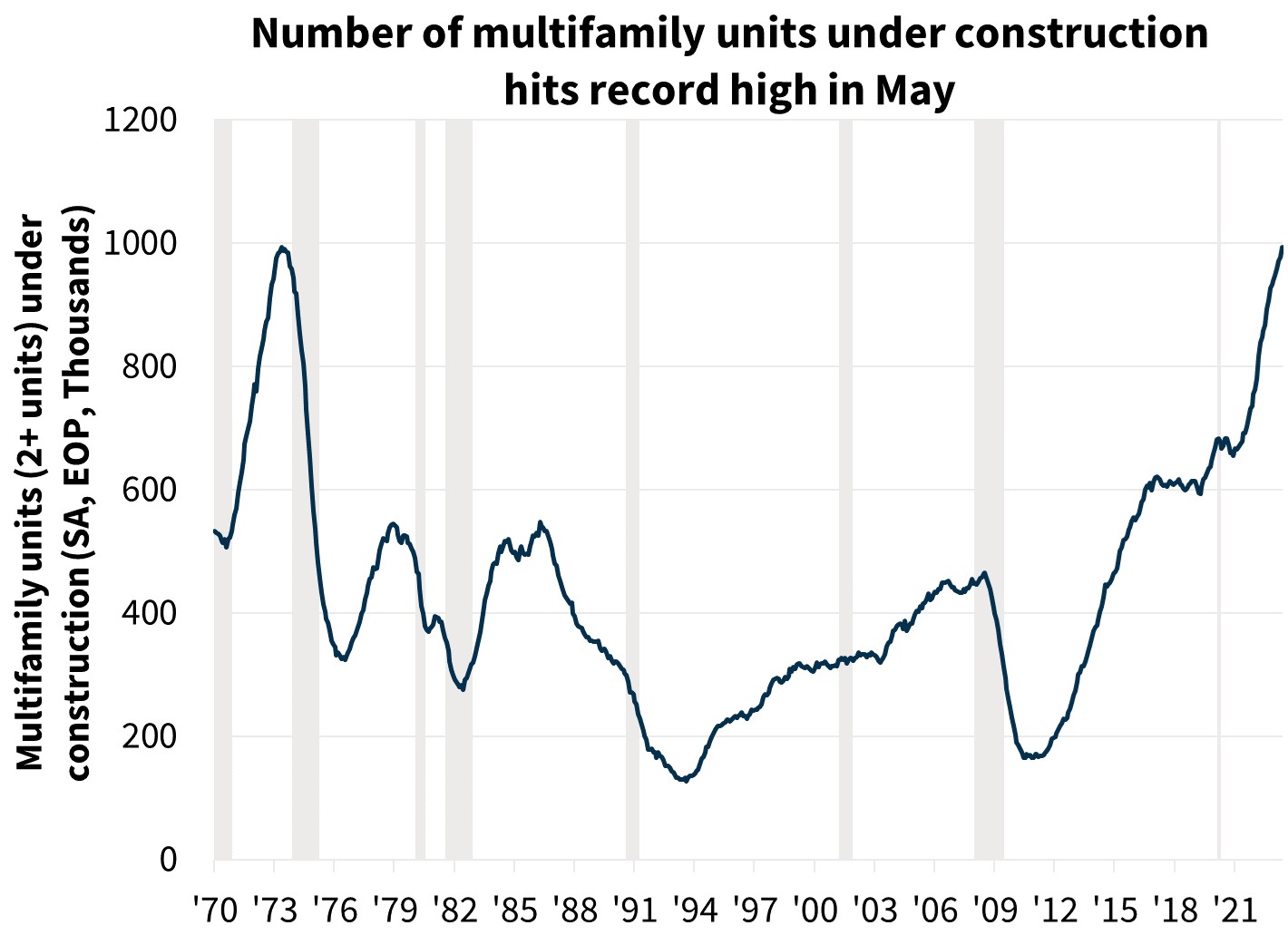Mixed Data Muddles Macroeconomic Forecast
While much of the economic data in recent months paints a mixed picture of the economy, the ongoing resilience in employment, strong housing demand, and current financial conditions do not point to an immediate downturn. We have therefore upgraded our 2023 GDP forecast to 0.1 percent from negative 0.3 percent on a Q4/Q4 basis, while also downgrading our 2024 forecast by a similar magnitude (0.8 percent from 1.2 percent). This reflects a shift in the start to our forecasted modest recession to the fourth quarter of 2023.
Timing the business cycle is difficult, therefore there are substantive risks to our inflation, interest rate, employment, and housing forecasts. However, fundamentally, we still see an economy in its late-cycle stage. While households are not overly leveraged by historical standards, the current pace of consumer spending remains unsustainable given current income levels and, to date, has been supported by drawing down pandemic-related savings and tapping into increasing debt. Since January 2020, real personal consumption is up 8.5 percent, while real disposable personal income is up only 2.7 percent. This divergence will need to converge, creating downward pressure on consumer spending growth relative to that of income. We expect the continued tightening of credit conditions, slowing bank lending, and shrinking money supply will eventually lead to a downward turn in business investment and hiring, eventually leading consumers to pull back on spending, coinciding with a recession.
Headline inflation is decelerating fast, in part due to large annual declines in energy prices that we believe largely reflect softening global economic growth. As measured by the Consumer Price Index (CPI), the annual pace of inflation decelerated to 4.0 percent in May, down from 4.9 percent in April. It is expected to fall further in coming months to a little over 3 percent. Core inflation is comparatively persistent, falling more gradually to only 5.3 percent in May, but this too is forecast to decelerate to around 4 percent by the end of 2023.
Housing activity continues to be shaped by the lack of inventory available for sale. Prices have firmed in recent months after softening over the second half of last year, and new home construction has taken the place of some missing existing inventory. Our home sales forecast is essentially unchanged this month; we expect sales in 2023 and 2024 to total 4.86 million and 4.97 million units, respectively. However, following the most recent blowout housing starts report (released following the completion of our forecast) there is substantial upside risk to our near-term new home sales and starts outlook. We project total single-family mortgage originations for 2023 to be $1.59 trillion, down from our previous forecast of $1.65 trillion. For 2024, we anticipate total single-family origination volumes of $1.90 trillion, compared to our prior forecast of $2.03 trillion.
A Murky View of the Economy
The annualized growth rate for real gross domestic product (GDP) has averaged 1.9 percent over the past two quarters, indicating the economy is generally growing at a solid pace. However, the same recent release that upwardly revised the first quarter estimate of GDP to 1.3 percent from 1.1 percent, also reported that gross domestic income (GDI) declined at a 2.3 percent annualized rate in the first quarter. In theory, GDP and GDI should equal one another, but they can diverge due to measurement differences. We suspect that the underlying trend is closer to the average of these metrics, which points to stalling economic growth.
Other economic data, such as faltering manufacturing output in the industrial production reports, the Institute for Supply Management (ISM) and regional manufacturing surveys, continue to trend downward, and generally lackluster retail sales since January supports the notion that demand has cooled and the economy is poised to slip into a recession. In contrast, housing construction remains robust, and strength in manufacturing construction and ongoing recovery in auto production are helping to offset weakness in broader commercial real estate and goods manufacturing. Corporate profits have also been stronger than expected and equity markets have rallied.
Nonfarm payroll employment growth continues to be robust and accelerated in both April and May, reaching job gains of 339,000 in the latter. But this same report also showed the unemployment rate rising three-tenths to 3.7 percent. While still at a low level, new unemployment claims have also trended upward in recent weeks. One way of measuring the labor market as a whole is a composite index published by the Kansas City Fed Bank that aims to capture labor market conditions holistically, and this measure points to a labor market that remains strong in absolute levels but is gradually turning.
Taken together, we see the economy remaining more resilient than we expected earlier in the year, but it is still on a decelerating path and additional drags are likely forthcoming. The full effects of tighter monetary policy and credit standards to date have yet to be fully felt in the real economy, and additional banking stress remains a possibility. The resumption of student loan repayments is also expected to drag on consumer spending in the second half of 2023. While the exact magnitude of the repayments is difficult to assess due to various income-based repayment plans, we expect that aggregate payments are in the range of 0.3 to 0.4 percent of nominal personal income.
Inflation to Slow Further, but Rebound Risks Remain
Headline CPI was below 5 percent on a year-over-year basis for the first time in two years in April, and then decelerated even further in May to 4 percent. Barring an unexpected energy or commodity price shock, we expect CPI will continue to decelerate through the rest of the year. This is due in part to favorable base effects because price growth in most CPI components was considerably stronger a year ago than it is currently (particularly in energy), which will cause the year-over-year CPI readings to decelerate. Additionally, shelter inflation, which comprises more than a third of the CPI and reflects housing and rental price growth with a significant lag, will begin to reflect more timely measures of market rent growth.
Though core inflationary pressures have been stickier, we think these, too, will cool. First, shelter inflation has an even larger impact on core CPI. Second, supply chain measures have improved greatly, and business input price growth has cooled considerably, as reflected in the producer price index and the ISM prices paid surveys. This will put downward pressure on consumer prices, particularly in goods. Finally, wage growth is likely to cool as well. The Job Openings and Labor Turnover Survey (JOLTS) quits rate, which, is highly correlated with wage growth, has steadily declined to just above its pre-pandemic level in April, suggesting wage-related inflationary pressures may soon return to pre-pandemic levels. Unit labor costs, a measure of the price of an hour of labor output, were revised downward for the past two quarters in the most recent release.
While underlying improvements in inflation dynamics are encouraging, as previously mentioned, continued deceleration is in part a function of economic activity slowing and expectations of a coming recession. If a recession is avoided over the coming quarters, this risks an entrenchment of current labor-market-related core inflationary pressure. Energy prices are also currently suppressed in part due to global growth concerns; if the economy proves to be more robust than expected, oil prices could rebound, reanimating topline inflation as well as consumer inflation expectations. Additionally, home price growth, on a monthly basis, returned to positive territory recently due to a mix of tighter inventories and somewhat lower mortgage rates, which highlights a risk that shelter could reinflate. One of the historical lessons of the 1970-80s inflationary era was that inflation can easily come roaring back if monetary policy easing begins prematurely. The current situation differs greatly from that era, however; we suspect that the Fed’s most recent guidance of 50 basis points more of rate hikes following the June pause was intended to guide financial markets such that intermediate- and longer-term interest rates do not start falling on future rate cut expectations. Until there is strong evidence of core inflation being contained, the worry of reaccelerating inflation via too-early policy easing will remain present.
Our baseline expectation is that the Fed will keep monetary policy tighter until core inflation is clearly subdued, which is not likely to occur until there is clear evidence of labor market softening. By the time that happens a recession will have likely been set in motion. We therefore see the Fed’s decision regarding how high and long to keep rates as a major risk over the next year, with the question of a downturn more a matter of “when” than “if”.
Improvement in For-Sale Home Inventories Was Short-Lived
For much of 2022, existing home sales slowed in response to mortgage rates that rose toward 7 percent. While the flow of new listings remained suppressed, the slower pace of sales led to a build-up of active inventories for sale and a modest decline in national house prices in late 2022. Though still at a low level, the active for-sale inventory of listings, according to Redfin, was up 29 percent on an annual basis at the end of January. However, as the spring homebuying season took off, housing demand has proven surprisingly resilient despite historically stretched affordability constraints and active listings have not grown in the usual seasonal pattern. According to the same Redfin data, active listings for the week ending June 13 were down around 6 percent from a year prior.
The housing market continues to have an extremely limited supply of homes for sale, in part because of the ongoing lock-in effect, in which existing owners are disincentivized to list their homes due to not wanting to give up a mortgage rate much lower than current market rates. Tight inventories are causing a slow pace of existing home sales, while also reanimating house price growth and demand for new homes. House price growth on an annualized basis grew around 8 percent in February and March, according to FHFA’s monthly Purchase-Only Index, and over 4 percent according to the Case-Shiller Index, the latter of which, amongst other differences, includes jumbo loan-financed properties.
The lack of existing homes for sale and firming house price growth is helping to support new construction. Single-family housing starts exploded in May by 18.5 percent to a seasonally adjusted annualized rate (SAAR) of 997,000 units. We believe that some of this jump is likely statistical noise in a notoriously volatile series and will likely pull back or be revised going forward. Single-family housing permits, which tend to be more indicative of the underlying trend, also rose, but by a smaller 4.8 percent and to a SAAR of 897,000 units, well below the pace of starts. Still, the permits data points to a clear upward trend in recent months, and this coincides with improvement in homebuilder sentiment. We expect starts to soften somewhat in coming quarters. However, this outlook is predicated on the business cycle turning. Without a broader economic slowdown, current home prices and lack of existing inventories will lead to more home construction.
There have been huge swings in the relationship between single-family housing starts and completions since the outbreak of the pandemic, where a surge in homebuyer demand and ongoing supply chain issues created major disruptions. However, typically the relationship between the two is similar, because when home builders complete one project they can then move on to a new one. Based on the pace of single-family housing completions, which we read as a better indicator of the construction industry’s current capacity, the single-family starts pace could indeed converge to around 1 million annualized units over the coming months, after backlog issues are cleared. This is to say that in the absence of a recessionary environment there is substantial upside risk to our new home sales and starts forecasts.
Multifamily housing starts also moved higher in May, to a SAAR of 634,000 units, the highest since 1986. We generally have a less bullish view on multifamily starts in the near term as vacancy rates are now near a more typical pre-pandemic level, rent growth is slowing, and construction loan credit conditions are tightening. Additionally, there is now a record number of units currently under construction and this will add additional supply to many markets. While the May 2023 report points to upside risk to our near-term forecast, we anticipate multifamily starts to slow meaningfully in coming quarters.
Mortgage Originations
We forecast single-family purchase mortgage originations to be $1.32 trillion in 2023 and $1.41 trillion in 2024, representing downward revisions of $41 billion and $60 billion, respectively, relative to last month’s forecast. As revisions to the home sales forecast were relatively minor this month, the bulk of this month’s revisions were due to recent incoming data on the share of transactions financed by cash, which has been trending upward lately. In a high-rate environment, it makes economic sense for some prospective homebuyers to avoid taking out a mortgage altogether. For refinance originations, we have revised down projected 2023 and 2024 volumes by $21 billion and $65 billion, respectively. The downward revision can be attributed to continued low refinance application volumes measured by our Refinance Application-Level Index (RALI) and a higher expected rate environment in this month’s forecast.
Economic & Strategic Research (ESR) Group
June 20, 2023
For a snapshot of macroeconomic and housing data between the monthly forecasts, please read ESR’s Economic and Housing Weekly Notes.
Data sources for charts: Bureau of Economic Analysis, Bureau of Labor Statistics, Redfin, Census Bureau.
Opinions, analyses, estimates, forecasts and other views of Fannie Mae's Economic & Strategic Research (ESR) Group included in these materials should not be construed as indicating Fannie Mae's business prospects or expected results, are based on a number of assumptions, and are subject to change without notice. How this information affects Fannie Mae will depend on many factors. Although the ESR group bases its opinions, analyses, estimates, forecasts and other views on information it considers reliable, it does not guarantee that the information provided in these materials is accurate, current or suitable for any particular purpose. Changes in the assumptions or the information underlying these views could produce materially different results. The analyses, opinions, estimates, forecasts and other views published by the ESR group represent the views of that group as of the date indicated and do not necessarily represent the views of Fannie Mae or its management.
ESR Macroeconomic Forecast Team
- Doug Duncan, SVP and Chief Economist
- Mark Palim, VP and Deputy Chief Economist
- Eric Brescia, Economics Manager
- Nick Embrey, Economist
- Nathaniel Drake, Economic Analyst
- Richard Goyette, Economic Analyst
